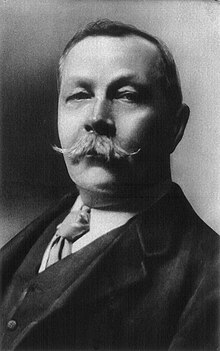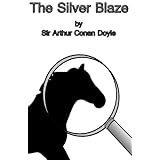About the Book: "Silver Blaze", one of the 56 Sherlock Holmes short stories written by British author Sir Arthur Conan Doyle, is one of 12 in the cycle collected as The Memoirs of Sherlock Holmes. Doyle ranked "Silver Blaze" 13th in a list of his 19 favourite Sherlock Holmes stories.
About the Author: Arthur Ignatius Conan Doyle was born on 22 May 1859 at 11 Picardy Place, Edinburgh, Scotland. From 1876 to 1881, he studied medicine at the University of Edinburgh, including a period working in the town of Aston (now a district of Birmingham) and in Sheffield, as well as in Shropshire at Ruyton-XI-Towns. While studying, Doyle began writing short stories. His earliest extant fiction, "The Haunted Grange of Goresthorpe", was unsuccessfully submitted to Blackwood's Magazine. His first published piece "The Mystery of Sasassa Valley", a story set in South Africa, was printed in Chambers's Edinburgh Journal on 6 September 1879. On 20 September 1879, he published his first non-fiction article, "Gelsemium as a Poison" in the British Medical Journal. In 1882 he joined former classmate George Turnavine Budd as his partner at a medical practice in Plymouth, but their relationship proved difficult, and Doyle soon left to set up an independent practice. Arriving in Portsmouth in June of that year with less than £10 (£900 today) to his name, he set up a medical practice at 1 Bush Villas in Elm Grove, Southsea. The practice was initially not very successful. While waiting for patients, Doyle again began writing stories and composed his first novels, The Mystery of Cloomber, not published until 1888, and the unfinished Narrative of John Smith, which would go unpublished until 2011. He amassed a portfolio of short stories including "The Captain of the Pole-Star" and "J. Habakuk Jephson's Statement", both inspired by Doyle's time at sea, the latter of which popularized the mystery of the Mary Celeste and added fictional details such as the perfect condition of the ship (which had actually taken on water by the time it was discovered) and its boats remaining on board (the one boat was in fact missing) that have come to dominate popular accounts of the incident. Doyle struggled to find a publisher for his work. His first significant piece, A Study in Scarlet, was taken by Ward Lock Co. on 20 November 1886, giving Doyle £25 for all rights to the story. The piece appeared later that year in the Beeton's Christmas Annual and received good reviews in The Scotsman and the Glasgow Herald. The story featured the first appearance of Watson and Sherlock Holmes, partially modeled after his former university teacher Joseph Bell. Doyle wrote to him, "It is most certainly to you that I owe Sherlock Holmes ... Round the center of deduction and inference and observation which I have heard you inculcate I have tried to build up a man." Robert Louis Stevenson was able, even in faraway Samoa, to recognize the strong similarity between Joseph Bell and Sherlock Holmes: "My compliments on your very ingenious and very interesting adventures of Sherlock Holmes. ... Can this be my old friend Joe Bell?" Other authors sometimes suggest additional influences—for instance, the famous Edgar Allan Poe character C. Auguste Dupin. A sequel to A Study in Scarlet was commissioned and The Sign of the Four appeared in Lippincott's Magazine in February 1890, under agreement with the Ward Lock company. Doyle felt grievously exploited by Ward Lock as an author new to the publishing world and he left them. Short stories featuring Sherlock Holmes were published in the Strand Magazine. Doyle first began to write for the 'Strand' from his home at 2 Upper Wimpole Street, now marked by a memorial plaque. In this period, however, Holmes was not his sole subject and in 1893, he collaborated with J.M. Barrie on the libretto of Jane Annie. Doyle was found clutching his chest in the hall of Windlesham Manor, his house in Crowborough, East Sussex, on 7 July 1930. He died of a heart attack at the age of 71. His last words were directed toward his wife: "You are wonderful." At the time of his death, there was some controversy concerning his burial place, as he was avowedly not a Christian, considering himself a Spiritualist. He was first buried on 11 July 1930 in Windlesham rose garden. He was later reinterred together with his wife in Minstead churchyard in the New Forest, Hampshire. Carved wooden tablets to his memory and to the memory of his wife are held privately and are inaccessible to the public. That inscription reads, "Blade straight / Steel true / Arthur Conan Doyle / Born May 22nd 1859 / Passed On 7th July 1930." The epitaph on his gravestone in the churchyard reads, in part: "Steel true/Blade straight/Arthur Conan Doyle/Knight/Patriot, Physician, and man of letters". Undershaw, the home near Hindhead, Haslemere, south of London, that Doyle had built and lived in between October 1897 and September 1907, was a hotel and restaurant from 1924 until 2004. It was then bought by a developer and stood empty while conservationists and Doyle fans fought to preserve it. In 2012 the High Court ruled that the redevelopment permission be quashed because proper procedure had not been followed. A statue honours Doyle at Crowborough Cross in Crowborough, where he lived for 23 years. There is also a statue of Sherlock Holmes in Picardy Place, Edinburgh, close to the house where Doyle was born.
My Review: In my opinion, one of the best short stories featuring Sherlock Holmes. The plot is simple, yet superb: Sherlock Holmes and his friend Dr. Watson travel by train to Dartmoor, summoned to investigate a crime that has convulsed the newspapers: the disappearance of the great race horse Silver Blaze and the murder of the horse's trainer, John Straker. Inspector Gregory has already arrested a man in connection with John Straker's murder by the time Holmes and Watson arrive at King's Pyland, the Dartmoor stable owned by Colonel Ross, from which Silver Blaze is missing. The suspect is Fitzroy Simpson, a London bookmaker who has come to Dartmoor (and specifically to King's Pyland) to gather information relating to his professional activities (which include wagers placed on favourites for the Wessex Cup, the race in which Silver Blaze is to run). However, to Holmes, from the outset, there seem to be a number of facts that do not fit the inspector's case against Simpson, damning as it looks. It seems odd, for instance, that he would lead the horse out on to the moor simply to injure or kill him. That could be done right in his stall. He could not have stolen the animal. What good would such a famous thoroughbred be to him? Why has an exhaustive search of the neighbourhood not turned up Silver Blaze? What has Simpson done with him?
Sherlock Holmes soon tracks down Silver Blaze, literally: his tracks (along with a man's) are clearly visible in the soil, albeit intermittently. Holmes also deduces why the police could not find the horse, despite having looked right at him. Holmes ensures Silver Blaze's safety, and turns his mind to other aspects of the case.
John Straker, Silver Blaze's late trainer, has been killed by a blow to the skull, presumably administered by Simpson with his "Penang lawyer", a clublike walking stick. Simpson's cravat is also found in Straker's hand, and the latter's coat is found draped over a furze bush. A knife is found at the crime scene—a peculiarly delicate-looking one, with a small blade. Dr. Watson, from his medical experience, identifies it as a cataract knife (used for the most delicate surgery). It is marked Weiss & Co., London. Useful as it is for that purpose, it would be unsuitable as a weapon; in addition, Straker also seems to have stabbed himself in the hip with it.
One of the stable lads, Ned Hunter, was on guard duty the night of the crime, but he proves to have been drugged with powdered opium placed in his supper. No one else who ate the curried mutton made at the Strakers' house that evening suffered any ill effects, but Hunter was in a profound stupor well into the next day.[3] Straker's pockets contained two interesting items: a tallow candle and a milliner's bill for (among other things) a 22-guinea dress, made out to one William Derbyshire. There is the curious incident with the dog, and a problem with the sheep kept at the stable: a shepherd tells Holmes that three of his animals have recently become suddenly lame.
Holmes's powers unravel the mystery, and lay bare what villainies there are to be exposed. He visits the milliner's shop in London and determines, using Straker's photograph, that Straker posed as Derbyshire. This establishes his motive: he had a mistress with expensive tastes, and tried to influence the race's outcome to earn himself a large sum of money.
The curried mutton was a clue, also; only such a spicy dish could have masked the taste of powdered opium, and it was impossible for Simpson to arrange a highly seasoned meal that evening for his purposes. Therefore, someone in the household must have conceived the idea—namely, Straker himself.
The "curious incident of the dog in the night-time" is easily explained: the dog made no noise, because no stranger was there. As Holmes explains: “I had grasped the significance of the silence of the dog, for one true inference invariably suggests others....Obviously the midnight visitor was someone whom the dog knew well. It was Straker who removed Silver Blaze from his stall and led him out on to the moor." Straker's purpose in doing this was to use the cataract knife to inflict a slight injury upon one of the horse's legs. He had thought to use Simpson's cravat (which the latter dropped when he was expelled from King's Pyland) as a sling to hold the horse's leg to cut it. But instead, Straker was killed when the horse, sensing that something was wrong, panicked and kicked the trainer in the head. The lame sheep had been used by Straker for practice.
Colonel Ross's main concern, of course, is getting his horse back safely. Holmes chooses not to tell Ross where his horse has been (although he has known all along) until after the Wessex Cup, which is won by Silver Blaze. At first the Colonel does not recognize his own horse, since the animal's distinguishing white markings have been covered with dye. The horse had been looked after by one of the Colonel's neighbours, Silas Brown, who had found him wandering the moor and hidden him in his barn. Holmes then explains the details of the case step-by-step to the satisfaction of the Colonel, Watson, and Inspector Gregory.
Gregory is one of the more competent police detectives Holmes works with in the course of his career. He conducts a thorough investigation of the crime before Holmes's arrival, and gathers all the evidence Holmes needs to solve the case. Holmes notes that Gregory is "an extremely good officer," and observes that the only quality he lacks is imagination—the ability to imagine what might have happened on a given occasion, and act on this intuition.
I recommend this book to the permanent library of any reader who appreciates a well written mystery.
If you read this review, feel free to leave a comment!



No comments:
Post a Comment